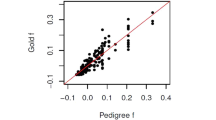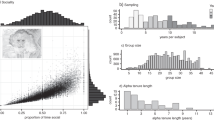Abstract
In an approach that explicitly incorporates genetic changes over consecutive generations of self-fertilization, we contrast the effect of different modes of inheritance for selfing rate upon the evolutionary equilibrium selfing rate. A monotonic decline of fitness with consecutive generations of selfing was assumed. We found the range of conditions permitting evolutionarily stable mixed-mating systems to increase with the number of genes controlling the selfing rate. When the mating system is controlled by a single locus with alternative alleles for complete selfing or outcrossing, alleles for selfing concentrate in inbred individuals and are exposed to stronger selection than the average inbreeding depression. By contrast, when alleles of small effect control the selfing rate, selfing rates do not vary as much between inbred vs. outcrossed individuals; this results in the broader stability of mixed mating. We also find that, provided selfing is not caused by recessive alleles, low levels of outcrossing can be maintained when the average relative fitness of selfed progeny is above 0.5. This is postulated to be due to a long-term advantage for occasional outcrossing in terms of the restoration of low inbreeding coefficients. The assumption of a mono-tonic decline in fitness with consecutive generations of selfing is also discussed.
Similar content being viewed by others
Article PDF
References
Barrett, S C H, and Charlesworth, D. 1991. Effects of a change in the level of inbreeding on the genetic load. Nature, 352, 522–524.
Barrett, S C H, and Eckert, C G. 1990. Variation and evolution of plant mating systems. In: Kawano, S. (eds.) Biological Approaches and Evolutionary Trends in Plants. Academic Press, London, pp. 229–254.
Barrett, S C H, Morgan, M T, and Husband, B C. 1989. The dissolution of a complex genetic polymorphism: the evolution of self-fertilization in tristylous Eichhornia paniculata. Evolution, 43, 1398–1416.
Campbell, R B. 1986. The interdependence of mating structure and inbreeding depression. Theor Pop Biol, 30, 232–244.
Charlesworth, D, and Charlesworth, B. 1987. Inbreeding depression and its evolutionary consequences. Ann Rev Ecol Syst, 18, 237–268.
Charlesworth, D, and Charlesworth, B. 1990. Inbreeding depression with heterozygote advantage and its effect on selection for modifiers changing the outcrossing rate. Evolution, 44, 870–888.
Charlesworth, D, Morgan, M T, and Charlesworth, B. 1990. Inbreeding depression, genetic load and the evolution of outcrossing rates in a multilocus system with no linkage. Evolution, 44, 1469–1489.
Damgaard, D, Couvet, D, and Loeschcke, V. 1992. Partial selfing as an optimal mating strategy. Heredity, 69, 289–295.
Ennos, R A, and Clegg, M T. 1983. Flower colour variation in the morning glory, Ipomoea purpurea. J Hered, 72, 247–250.
Fisher, R A. 1941. Average excess and average effect of a gene substitution. Ann Eugen, 11, 53–63.
Hedrick, P W, and Muona, O. 1990. Linkage of viability genes to marker loci in selfing organisms. Heredity, 64, 67–72.
Hallauer, A R, and Sears, J H. 1973. Changes in quantitative traits associated with inbreeding in a synthetic variety of maize. Crop Sci, 13, 327–330.
Hollingsworth, M J, and Maynard Smith, J. 1955. The effects of inbreeding on rate of development and on fertility in Drosophila subobscura. J Genet, 53, 295–314.
Holsinger, K E. 1988. Inbreeding depression doesn't matter: the genetic basis of mating system evolution. Evolution, 42, 1235–1244.
Holsinger, K E. 1991. Inbreeding depression and the evolution of plant mating systems. TREE, 6, 307–308.
Holsinger, K E, Feldman, M W, and Christiansen, F B. 1984. The evolution of self-fertilization in plants: a population genetic model. Am Nat, 124, 446–453.
Jones, D F. 1917. Dominance of linked factors as a means of accounting for heterosis. Genetics, 2, 466–479.
Jones, D F. 1957. Gene action in heterosis. Genetics, 42, 93–103.
Lande, R, and Schemske, D W. 1985. The evolution of self fertilization and inbreeding depression in plants. I. Genetic models. Evolution, 39, 24–40.
Latta, R G. 1992. Inbreeding Depression and Mixed Mating Systems in Mimulus M.Sc. Thesis, University of Toronto.
Lloyd, D G. 1979. Some reproductive factors affecting the selection of self fertilization in plants. Am Nat, 113, 67–79.
Marshall, D F, and Abbott, R J. 1982. Polymorphism for outcrossing frequency at the ray floret locus in Senecio vulgaris L. I. Evidence. Heredity, 48, 227–235.
Marshall, D F, and Abbott, R J. 1984. Polymorphism for outcrossing frequency at the ray floret locus in Senecio vulgaris L. II. Confirmation. Heredity, 52, 331–336.
Maynard-Smith, J. 1977. The sex habit in plants and animals. In: Christiansen, F. B. and Fenchel, T. M. (eds) Measuring Selection in Natural Populations Springer-Verlag, Berlin, pp. 265–273.
Monti, L M, and Frusciante, L. 1984. Selection methods for yield improvement in faba beans. In: Hebblethwaite, P. D. et al (eds) Vicia faba: Agronomy, Physiology and Breeding. Dr W. Junk Publishers, The Hague.
Motton, A F, and Antonovics, J. 1992. Determinants of outcrossing rate in a predominantly self-fertilizing weed, Datura stramonium (Solanaceae). Am J Bot, 74, 419–427.
Nagylaki, T. 1976. A model for the evolution of self-fertilization and vegetative reproduction. J Theoret Biol, 58, 55–58.
Ritland, K M, and Ganders, F R. 1987. Covariation of selfing rates with parental gene fixation indices within populations of Mimulus guttatus. Evolution, 41, 760–771.
Ritland, C, and Ritland, K M. 1990. Variation of sex allocation among eight taxa of the Mimulus guttatus species complex (Scrophulariaceae). Am J Bot, 76, 1731–1740.
Schuster, W, and Michael, J. 1976. Untersuchungen uber Inzuchtdepression und Heterosiseffekte bei Raps (Brassica napus oleifera). Zeitschrift fur Planzenzuchtung, 77, 56–66.
Shore, J S, and Barrett, S C H. 1990. Quantitative genetics of floral characters in homostylous Turnern ulmifolia var. angustifolia Wild. (Turneraceae). Heredity, 64, 105–112.
Stebbins, G L. 1950. Variation and Evolution in Plants. Columbia University Press, New York.
Uyenoyama, M K, and Waller, D M. 1991a. Coevolution of self-fertilization and inbreeding depression. I. Mutation-selection balance at one and two loci. Theor Pop Biol, 40, 14–46.
Uyenoyama, M K, and Waller, D M. 1991b. Coevolution of self-fertilization and inbreeding depression. II. Symmetric overdominance in viability. Theor Pop Biol, 40, 46–77.
Uyenoyama, M K, and Walker, D M. 1991c. Coevolution of self-fertilization and inbreeding depression. III. Homozygous lethal mutations at multiple loci. Theor Pop Biol, 40, 173–210.
Waller, D M. 1986. Is there disruptive selection for self-fertilization? Am Nat, 128, 421–426.
Wells, H. 1979. Self-fertilization: Advantageous or deleterious. Evolution, 33, 252–255.
Wilton, A N, Joseph, M G, and Sved, J A. 1989. Can chromosomal heterosis in Drosophila be explained by deleterious recessive genes? Negative results from a dichromosomal population test. Genet Res Camb, 53, 129–140.
Author information
Authors and Affiliations
Rights and permissions
About this article
Cite this article
Latta, R., Ritland, K. Models for the evolution of selfing under alternative modes of inheritance. Heredity 71, 1–10 (1993). https://doi.org/10.1038/hdy.1993.101
Received:
Issue date:
DOI: https://doi.org/10.1038/hdy.1993.101
Keywords
This article is cited by
-
High lifetime inbreeding depression counteracts the reproductive assurance benefit of selfing in a mass-flowering shrub
BMC Evolutionary Biology (2014)
-
Evolutionarily stable mixed mating in a variety of genetic systems
Evolutionary Ecology (2011)
-
Among- and within-population variation in outcrossing rate of a mixed-mating freshwater snail
Heredity (2006)
-
Shell shape of the land snail Cornu aspersum in North Africa: unexpected evidence of a phylogeographical splitting
Heredity (2003)
-
Quantitative genetics of mating system divergence in the yellow monkeyflower species complex
Heredity (1994)



